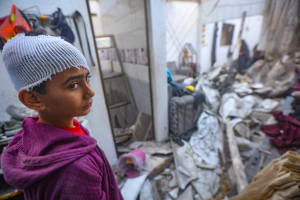Missiles in homes - IDF shows how Hezbollah hides weapons in civilian homes in Lebanon
Despite massive bombardment of Hezbollah sites, terror group still retains its ability to strike deep in Israel

Following a series of strikes on Hezbollah sites across Lebanon on Monday, IDF Spokesman Brig.-Gen. Daniel Hagari conducted a press briefing providing evidence of Hezbollah’s use of civilian homes as sites for storing and launching rockets.
The pictures and video justified the IDF’s strikes on civilian buildings, as well as calls to Lebanese civilians to evacuate areas with known Hezbollah munitions. In the briefing, Hagari himself repeated the appeal to the local residents: “Stay away from areas where Hezbollah operatives and the organization's weapons are located.”
The IDF had issued warnings over radio broadcasts, with phone calls, and via SMS, warning Lebanese civilians in areas known to have Hezbollah rocket launchers to stay at least 1 km away from such facilities.
“As part of our efforts to mitigate harm to civilians, we provided advanced warnings to civilians in specific villages in Lebanon where Hezbollah embedded its military assets and weapons, and warned them to move out of harm's way,” the IDF spokesman said.
Following our strikes on these targets, many secondary explosions were seen, proving that these were sites embedded with powerful weapons and explosives inside civilian buildings.
— LTC Nadav Shoshani (@LTC_Shoshani) September 23, 2024
We don’t know the exact casualty count from Lebanon, but we do know amongst the casualties are… pic.twitter.com/HfrHrdknGJ
“Since October 8th, the Hezbollah terrorist organization has fired over 9,000 rockets, missiles, and UAVs at Israeli families, homes, and communities,” Hagari said, noting that over 700 such attacks had been launched in the last week.
He explained that Hezbollah had been planning an invasion of northern Israel similar to the Oct. 7 attacks carried out by the Hamas terrorist organization in Gaza. They called the plan “Conquer the Galilee.”
"On Friday, the IDF conducted a precise strike based on intelligence on Ibrahim Aqil – the architect of this plan - and other senior Radwan Force commanders in Beirut,” Hagari said. “At the time of the strike, these Hezbollah commanders were meeting to plan an October 7th-style attack – in northern Israel.”
“Over the past day, the IDF conducted precise, intelligence-based strikes on approximately 1,300 Hezbollah terror targets in Lebanon in order to remove immediate threats against the State of Israel,” he explained, referring to strikes earlier on Tuesday.
The strikes took out long-range cruise missiles, heavyweight rockets, rockets with warheads capable of carrying 100kg of explosives, short-range rockets, and explosive UAVs which were all aimed at northern Israel.
However, the most striking detail in Hagari’s briefing was evidence backing the claim that Hezbollah is putting active launchers and munitions inside of civilian homes and structures.
“Hezbollah located its strategic munitions and capabilities inside Lebanese villages and civilian homes and intended to fire them toward civilians in Israel while endangering the Lebanese civilian population.”
To support this claim, the IDF presented several images of Hezbollah launchers positioned inside homes in southern Lebanon, along with a composite video combining drone footage and a 3D reconstruction of a building where a Hezbollah cruise missile was concealed.
IDF Spokesman Rear Adm. Daniel Hagari issues a message to Lebanese civilians in border villages, warning them against Hezbollah's use of their homes to store weaponry.
— Emanuel (Mannie) Fabian (@manniefabian) September 23, 2024
"To all the residents of the villages in Lebanon, in the near future we will strike terror targets in Lebanon.… pic.twitter.com/7JtCnvXe3C
The video showed the launcher being prepared for use shortly before being targeted by an IDF drone strike. The military also released footage of airstrikes on civilian buildings, where significant secondary explosions indicated the presence of munitions stored inside the structures.
“As a result of many of the strikes, there were significant secondary explosions caused by Hezbollah’s weapons that were being stored inside the buildings,” Hagari said.
The IDF spokesman stated the presence of launchers in civilian homes “is an immediate and real threat to Israeli civilians, and we have an obligation to remove it.”
In this video, you can see another example of Hezbollah’s way of operating:
— LTC Nadav Shoshani (@LTC_Shoshani) September 24, 2024
The precise strike on the house where Hezbollah had been storing ammunition, revealed the rocket hidden inside by triggering its launch.
Hezbollah has turned southern Lebanon into a place where instead… pic.twitter.com/xwB3ytL20o
Military analysts have warned about Hezbollah’s missile and rocket threat for years, ever since the Second Lebanon War in 2006.
While most of Hezbollah’s approximately 200,000 projectiles are believed to be unguided, there are estimates that at least 1,500 have been converted into PGMs (precision-guided munitions) with the use of retrofit kits provided by Iran. These kits allow the terror group to turn pre-existing rockets into missiles capable of targeting specific sites.
Until recently, Hezbollah has been content to mainly launch smaller short-range rockets at Israel’s northern border communities. However, with the ground war in Gaza moving to a less intense phase, and with over 60,000 evacuees from its northern communities, Israel has signaled its intention to shift focus north toward Hezbollah.
Last week, Defense Minister Yoav Gallant said Israel is “at the start of a new phase in the war,” following two days of explosions that killed dozens and injured thousands of Hezbollah operatives.
“The ‘center of gravity’ is moving north, meaning that we are allocating forces, resources, and energy for the northern arena,” Gallant said.
Just days later, Israel eliminated two of Hezbollah’s most senior commanders, as well as most of the command staff of its elite Radwan Unit in an airstrike in the capital city of Beirut. The IDF also targeted about 400 Hezbollah sites as it increased the frequency and number of strikes on Hezbollah’s infrastructure.
In response, Hezbollah began to use some of its longer-range Fadi 1 and Fadi 2 rockets, reaching deeper into Israel. Some reports claimed that the terror group also fired a Fajr 5 guided missile.
Prime Minister Benjamin Netanyahu delivered a video address directed at the international community on Sunday, saying: “No country can accept the wanton rocketing of its cities.”
He also said Israel “will take whatever action is necessary to restore security and to bring our people safe back to their homes.”
With the start of Operation Northern Arrows, the IDF appears to be targeting the more exposed launch positions in Hezbollah’s infrastructure, including those hidden in civilian areas.
Despite the apparent success of these strikes, Army Radio military correspondent Doron Kadosh said Hezbollah still has significant rocket and missile capabilities.
“The IDF damaged these capabilities – but still did not completely destroy them. Hezbollah certainly still has very large-scale rocket firing capabilities of all the listed types,” Kadosh said.
He claimed that Israel has refrained from striking “precision-guided missiles, long-range missiles, and more.”
This may be because Hezbollah appears to have these more strategically significant systems in harder-to-hit areas, including underground launchers, which the group recently showed off.
Several of these launchers are in specially dug launch tunnels that can be fired and resupplied completely underground. Hezbollah calls these facilities “Imad 4” and recently released a video of one of the sites.
By attacking the more exposed launch sites, the IDF is apparently engaging in what IDF Chief of Staff Herzi Halevi called “a proactive offensive operation.”
In a recent video, Halevi said the IDF is “removing military infrastructure that Hezbollah built for 20 years.”
It is not yet clear how long Operation Northern Arrows will last, and whether it will lead to a ground campaign, something that the international community is opposed to.
The IDF and the political echelon have said the goal is to allow the safe return of the evacuees from the north. Unless the rest of Hezbollah’s missile arsenal is similarly dealt with, particularly its precision-guided and long-range projectiles, that goal could still be a long way off.
Despite the IDF’s intense bombardment of Hezbollah positions, the terror group managed to fire over 350 projectiles at Israel in the past couple of days, turning southern Lebanon and northern Israel into a battlefield.
“Let me be clear: Hezbollah is responsible for this situation,” Hagari said in the Monday briefing. “This is Hezbollah’s plan – to turn southern Lebanon into a battlefield for its attacks on Israel.”
“We cannot accept a terrorist group storing weapons inside people’s homes and using them to fire at other civilian communities. The international community must condemn Hezbollah’s grave violations of international law and actions that endanger civilians on both sides of the border.”

J. Micah Hancock is a current Master’s student at the Hebrew University, pursuing a degree in Jewish History. Previously, he studied Biblical studies and journalism in his B.A. in the United States. He joined All Israel News as a reporter in 2022, and currently lives near Jerusalem with his wife and children.
You might also like to read this:













